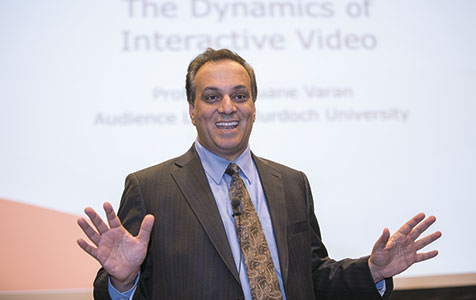Research undertaken in Perth may help to solve the growing problem of multi-screen inattention.


Research undertaken in Perth may help to solve the growing problem of multi-screen inattention.
As much as 90 per cent of media is now consumed on a screen of some sort – be it a TV, tablet, smartphone, desktop or laptop computer. What’s more, we are increasingly watching more than one screen at a time, a practice known as multi-screening, or simultaneous media use.
This is not a new phenomenon. Back in the 1930s, researchers found that people often engaged in another activity while listening to the radio. In those days, people might have been sewing with the radio on, or having a meal or reading the paper. These days we are watching TV while checking emails on our smartphone or browsing the web on a tablet.
Perth-based Disney Media and audience researcher Duane Varan have been researching how people interact with TV and other devices since the 1990s.
Speaking at XMediaLab’s recent ‘Video+Social’ conference in Perth, the Murdoch University professor argued that multi-screening was a huge problem for advertisers.
“What we have found is that the second screen becomes the first screen,” Dr Varan told conference delegates.
TV is most often the common factor when people are multi-screening, but it seems the TV is the screen that misses out. The smaller screen people hold in their hands more often than not relegates the bigger screen to the background.
Dr Varan said research undertaken in Perth during the past decade increasingly supported this assertion, with the growth of smartphones and tablets strengthening the trend in recent years.
“For example, in one study we found that if people only used the TV as their screen then their recall of ad messages the day after was as high as 60 per cent,” he said.
“But if you gave them another device as well, recall of the TV ad collapsed to less than 10 per cent.
“This is now the biggest problem the advertising industry faces … and they don't even know it yet.”
Some TV advertisements try to take advantage of multi-screening, by providing calls to action within their campaigns – ‘like our Facebook page’, or ‘enter the competition now’. But the latest research from Millward Brown in the US suggests this strategy is doomed to fail.
Most of the time the second screen (smartphone or tablet) is being used in some unrelated way, distracting the attention well away from the TV’s content and advertising messages.
Only 14 per cent of multi-screening activity is what’s called ‘meshing’, where the user adds to their TV viewing experience with their second screen activity – such as following along with ABC TV’s Q&A program using the #qanda hashtag, or looking up someone on Wikipedia. Most of the time we are distractedly catching up on social media or simply filling time during ad breaks.
Dr Varan believes he has the answer.
“The solution is fairly straightforward. Advertisers have to build what we call a cognitive bridge; that is, they should use synchronised visual banners linking the two screens. Then you can build a connection and the benefits can flow from one screen to the other and back again,” he said.
However synchronising message on various screens simultaneously is no easy feat, according to Carlo Bertozzi of digital marketing agency Longtail.
“If people are cognitively incapable of giving two screens their full attention then I’d question whether it’s cost effective trying to build cognitive bridges, which pre-suppose you could easily synchronise content in the first place“ Mr Bertozzi told Business News.
“Where the two screens are bridged by an active element, such as using Shazam (to download a piece of music), then the two screens can work more effectively together; but the scale of that type of campaign engagement will always be relatively limited.”
Clearly there is still much work to be done here to bridge the theory with the practice. What Dr Varan’s work does show is that marketers (especially in the traditional media) may need to think differently about how to engage with their audiences.
Charlie Gunningham is an internet entrepreneur and GM of Digital at Business News
Twitter@chazgunningham






